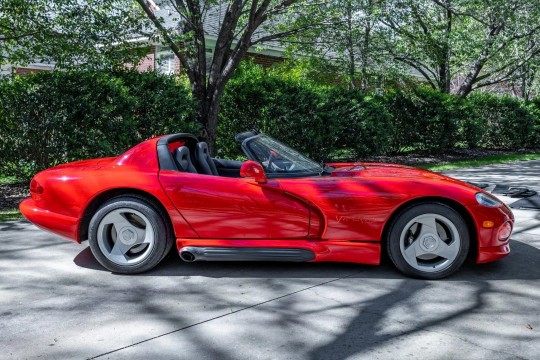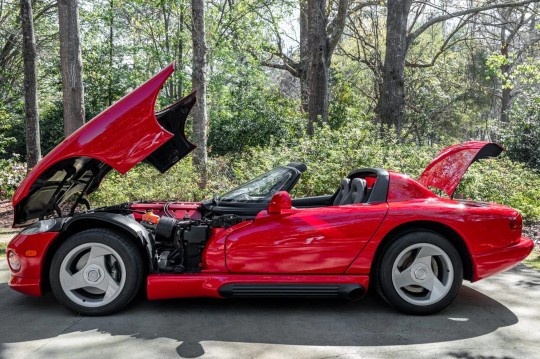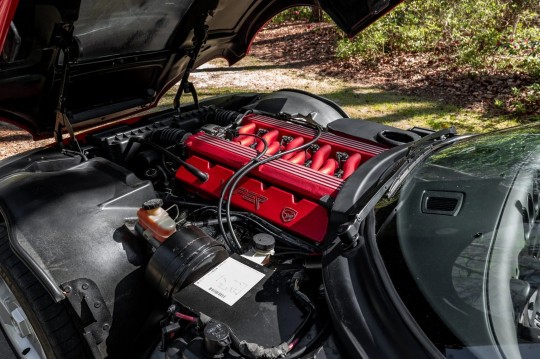The history of the Vipers begins at the end of the eighties. But before we get to the car, we need to take a look at what inspired its creation. To do that, we have to go back to 1962.
Then Carrol Shelby created an unimaginably fast and dangerous car, which you may know as the Cobra. The Cobra was born with the help of Lee Iaccoca, and planted the seed of American speed and power by destroying its European counterparts.
The dream of speed would be interrupted, however, due to mandatory anti-pollution rules and the oil crisis, which I mentioned once or twice every time I talked about these classic machines. In addition, the oil crisis hit all manufacturers hard, but Chrysler in particular suffered a heavy defeat. Meanwhile, Lee Iaccoca had reached the top of Chrysler and was determined to return the company to its former glory.

Photo: Pwright2/Bring a Trailer
To do that, he needed a plan. First, Chrysler acquired AMC and Lamborghini. The three shared resources, thus reducing development costs and expanding the company’s influence. He then came up with a revolutionary idea: build all the cars on the same front-wheel-drive platform known as the K-Car.
But the K-Car platform consisted of boring cars and sales did not live up to expectations. So along comes Bob Lutz, who was determined to bring Dodge back to its old performance orientation. He had a replica Shelby Cobra, and that served as inspiration for a no-nonsense performance car. The task was given to one of the best designers Chrysler had on hand, Tom Gale. He submitted a sketch to Bob Lutz. It was approved, and the Viper project was given the green light.

Photo: Pwright2/Bring a Trailer
Team Viper met in secret. A team full of rag tag engineers who had the same desire: to build a car whose sole purpose is speed above all else. And that’s what they did. They had no rules other than to keep the project quiet and not spend too much. To keep the budget low, they borrowed parts wherever they could: trucks, old race cars, everything.
A concept car was finished, powered by an old racing Hemi V8. Now, there was a small hair left in the soup: to convince Lee Iaccoca to give the green light to start production. Fortunately, Bob Lutz had a trick up his sleeve. When he went to Iaccoca’s office to pitch the idea, he brought with him a secret weapon: Carrol Shelby.
After seeing the prototype and speaking with Shelby, Iaccoca agreed, and at the 1989 International Auto Show, the Viper was revealed to a stunned audience.
So the first generation Viper started production in 1991 and today we have an incredible 1994 example here to feast our eyes on. But today I’m going to do things a little differently, and the first thing I’m going to talk about is the engine.

Photo: Pwright2/Bring a Trailer
You see, the prototype was a hit with the public, but essentially, it was nothing more than a sheet metal mockup powered by an old V8. That aging engine had to go, but whether it was laziness, convenience, or cheapness, the Viper got a truck engine. That said, the engine was sent to Lamborghini – there, it was recast in aluminum, its parts were refined, and there’s your Viper engine.
The 8.0-liter (488 ci) pushrod V10 produced a monstrous 400 hp (405 hp). All that pushing made the viper fast. To quote Jeremy Clarkson, you didn’t really drive it; you just endured The fact that your only safety feature was a seat belt didn’t help either.
The rawness is in every inch of the car. The exterior of this particular Viper is finished in Viper Red. Complementing the intimidating looks are 17-inch three-spoke wheels and perhaps the Viper’s most interesting feature: no door handles.
Stepping inside, you won’t find much. You get leather bucket seats, air conditioning, stereo, and that’s pretty much it. You’ll also get a steering wheel that you’ll be holding on to for dear life when you decide to mash the throttle.

Photo: Pwright2/Bring a Trailer
Power is sent to the rear wheels via a Tremec T-56 six-speed manual transmission, a limited-slip differential, and 335-wide rear tires! Another interesting feature of this car is the side exit exhaust. This design was short-lived, however, as people burned their feet getting out of it. So for the 1996 model year, the side exit exhaust was dropped in favor of a rear exit system that was centrally mounted.
Keeping it a little planted, the Viper gets independent suspension at all four corners, but you still had to contend with that big chunk of a V10 hanging out the front. Another hairy aspect of the ride is the braking system. Like I said, this is a very simple car, and the only thing keeping you on the road is how good a driver you are. So it has four-wheel disc brakes with huge calipers but no absthat will definitely get you going.
This particular 1994 Viper is up for auction in Sumter, South Carolina. It has 21,000 miles (34,000 km) on the clock, a clean Carfax report and a clean South Carolina title. The price currently stands at $27,000 with five days left in the auction.
The next vipers were tamed a bit, but still kept that scary and fast philosophy. This car is the automotive equivalent of rock and roll cranked up to 11, a dying type of car we’ll probably never see again.


